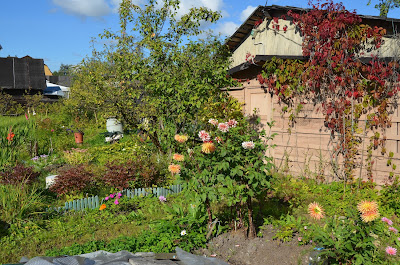Russian dacha gardens, a threatened species?
Thursday, September 5, 20130 comments
Dachas, second homes or just simple little weekend hideaways are a crucial part of Russian life. Similar in concept to German or Dutch leisure gardens, they are organised in colonies, a place for people to garden, and stay at the weekend. During the Soviet era they were a crucial part of the economy as they allowed people to grow their own fruit and vegetables, either for their own consumption or barter; the family Lada or Moscowitch car might be fixed in exchange for a box of produce.
Anna Benn, a garden designer near Bath, who has lived in Russia suggested we take a train out of St. Petersburg to have a look. I don't know whether our colony, near Darskoe Selo station, is typical, but it did rather look as if the traditional dacha garden might be an endangered species.
Traditionally, they have looked very much like our idea of a cottage garden: fruit, flowers and veg all in together. During the brief, but warm, Russian summer a lot of growing can happen. Phlox, rudbeckia, helenium and other American-origin perennials do particularly well. Indeed these gardens have proved a useful hunting ground for old pre-WW2 perennial varieties.
Unconventional fruit is quite common, such as Hippophae rhamnoides (above) grown for its Vitamine C rich berries, and black Aronia berries for jam making
Many dacha gardens are falling into disrepair as the older generation dies or retreats from working these plots. The arrival of shops with things in them to sell (a major innovation in the Russian economy) has meant their usefulness has declined too. More Russians can afford to travel too.
Some people are buying multiple plots and then constructing large houses on them. Eventually a lot will probably go this way. We met a young woman in a smart car, who spoke good English, who was mystified we were there, and not doing the sights in St.Petersburg - her family were building here too. I don't think she'll take up gardening yet.



















Post a Comment